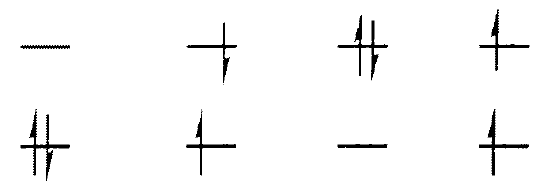2.9: Configuration Interaction
- Page ID
- 364742
\( \newcommand{\vecs}[1]{\overset { \scriptstyle \rightharpoonup} {\mathbf{#1}} } \)
\( \newcommand{\vecd}[1]{\overset{-\!-\!\rightharpoonup}{\vphantom{a}\smash {#1}}} \)
\( \newcommand{\id}{\mathrm{id}}\) \( \newcommand{\Span}{\mathrm{span}}\)
( \newcommand{\kernel}{\mathrm{null}\,}\) \( \newcommand{\range}{\mathrm{range}\,}\)
\( \newcommand{\RealPart}{\mathrm{Re}}\) \( \newcommand{\ImaginaryPart}{\mathrm{Im}}\)
\( \newcommand{\Argument}{\mathrm{Arg}}\) \( \newcommand{\norm}[1]{\| #1 \|}\)
\( \newcommand{\inner}[2]{\langle #1, #2 \rangle}\)
\( \newcommand{\Span}{\mathrm{span}}\)
\( \newcommand{\id}{\mathrm{id}}\)
\( \newcommand{\Span}{\mathrm{span}}\)
\( \newcommand{\kernel}{\mathrm{null}\,}\)
\( \newcommand{\range}{\mathrm{range}\,}\)
\( \newcommand{\RealPart}{\mathrm{Re}}\)
\( \newcommand{\ImaginaryPart}{\mathrm{Im}}\)
\( \newcommand{\Argument}{\mathrm{Arg}}\)
\( \newcommand{\norm}[1]{\| #1 \|}\)
\( \newcommand{\inner}[2]{\langle #1, #2 \rangle}\)
\( \newcommand{\Span}{\mathrm{span}}\) \( \newcommand{\AA}{\unicode[.8,0]{x212B}}\)
\( \newcommand{\vectorA}[1]{\vec{#1}} % arrow\)
\( \newcommand{\vectorAt}[1]{\vec{\text{#1}}} % arrow\)
\( \newcommand{\vectorB}[1]{\overset { \scriptstyle \rightharpoonup} {\mathbf{#1}} } \)
\( \newcommand{\vectorC}[1]{\textbf{#1}} \)
\( \newcommand{\vectorD}[1]{\overrightarrow{#1}} \)
\( \newcommand{\vectorDt}[1]{\overrightarrow{\text{#1}}} \)
\( \newcommand{\vectE}[1]{\overset{-\!-\!\rightharpoonup}{\vphantom{a}\smash{\mathbf {#1}}}} \)
\( \newcommand{\vecs}[1]{\overset { \scriptstyle \rightharpoonup} {\mathbf{#1}} } \)
\( \newcommand{\vecd}[1]{\overset{-\!-\!\rightharpoonup}{\vphantom{a}\smash {#1}}} \)
\(\newcommand{\avec}{\mathbf a}\) \(\newcommand{\bvec}{\mathbf b}\) \(\newcommand{\cvec}{\mathbf c}\) \(\newcommand{\dvec}{\mathbf d}\) \(\newcommand{\dtil}{\widetilde{\mathbf d}}\) \(\newcommand{\evec}{\mathbf e}\) \(\newcommand{\fvec}{\mathbf f}\) \(\newcommand{\nvec}{\mathbf n}\) \(\newcommand{\pvec}{\mathbf p}\) \(\newcommand{\qvec}{\mathbf q}\) \(\newcommand{\svec}{\mathbf s}\) \(\newcommand{\tvec}{\mathbf t}\) \(\newcommand{\uvec}{\mathbf u}\) \(\newcommand{\vvec}{\mathbf v}\) \(\newcommand{\wvec}{\mathbf w}\) \(\newcommand{\xvec}{\mathbf x}\) \(\newcommand{\yvec}{\mathbf y}\) \(\newcommand{\zvec}{\mathbf z}\) \(\newcommand{\rvec}{\mathbf r}\) \(\newcommand{\mvec}{\mathbf m}\) \(\newcommand{\zerovec}{\mathbf 0}\) \(\newcommand{\onevec}{\mathbf 1}\) \(\newcommand{\real}{\mathbb R}\) \(\newcommand{\twovec}[2]{\left[\begin{array}{r}#1 \\ #2 \end{array}\right]}\) \(\newcommand{\ctwovec}[2]{\left[\begin{array}{c}#1 \\ #2 \end{array}\right]}\) \(\newcommand{\threevec}[3]{\left[\begin{array}{r}#1 \\ #2 \\ #3 \end{array}\right]}\) \(\newcommand{\cthreevec}[3]{\left[\begin{array}{c}#1 \\ #2 \\ #3 \end{array}\right]}\) \(\newcommand{\fourvec}[4]{\left[\begin{array}{r}#1 \\ #2 \\ #3 \\ #4 \end{array}\right]}\) \(\newcommand{\cfourvec}[4]{\left[\begin{array}{c}#1 \\ #2 \\ #3 \\ #4 \end{array}\right]}\) \(\newcommand{\fivevec}[5]{\left[\begin{array}{r}#1 \\ #2 \\ #3 \\ #4 \\ #5 \\ \end{array}\right]}\) \(\newcommand{\cfivevec}[5]{\left[\begin{array}{c}#1 \\ #2 \\ #3 \\ #4 \\ #5 \\ \end{array}\right]}\) \(\newcommand{\mattwo}[4]{\left[\begin{array}{rr}#1 \amp #2 \\ #3 \amp #4 \\ \end{array}\right]}\) \(\newcommand{\laspan}[1]{\text{Span}\{#1\}}\) \(\newcommand{\bcal}{\cal B}\) \(\newcommand{\ccal}{\cal C}\) \(\newcommand{\scal}{\cal S}\) \(\newcommand{\wcal}{\cal W}\) \(\newcommand{\ecal}{\cal E}\) \(\newcommand{\coords}[2]{\left\{#1\right\}_{#2}}\) \(\newcommand{\gray}[1]{\color{gray}{#1}}\) \(\newcommand{\lgray}[1]{\color{lightgray}{#1}}\) \(\newcommand{\rank}{\operatorname{rank}}\) \(\newcommand{\row}{\text{Row}}\) \(\newcommand{\col}{\text{Col}}\) \(\renewcommand{\row}{\text{Row}}\) \(\newcommand{\nul}{\text{Nul}}\) \(\newcommand{\var}{\text{Var}}\) \(\newcommand{\corr}{\text{corr}}\) \(\newcommand{\len}[1]{\left|#1\right|}\) \(\newcommand{\bbar}{\overline{\bvec}}\) \(\newcommand{\bhat}{\widehat{\bvec}}\) \(\newcommand{\bperp}{\bvec^\perp}\) \(\newcommand{\xhat}{\widehat{\xvec}}\) \(\newcommand{\vhat}{\widehat{\vvec}}\) \(\newcommand{\uhat}{\widehat{\uvec}}\) \(\newcommand{\what}{\widehat{\wvec}}\) \(\newcommand{\Sighat}{\widehat{\Sigma}}\) \(\newcommand{\lt}{<}\) \(\newcommand{\gt}{>}\) \(\newcommand{\amp}{&}\) \(\definecolor{fillinmathshade}{gray}{0.9}\)The best energies obtained at the Hartree-Fock level are still not accurate, because they use an average potential for the electron-electron interactions. Configuration interaction (CI) methods help to overcome this limitation. Because electrons interact and repel each other, their motion in atoms is correlated. When one electron is close to the nucleus, the other tends to be far away. When one is on one side, the other tends to be on the other side. This motion is related to that of two people playing tag around a house. The exact wavefunction must depend upon the coordinates of both electrons simultaneously. We have shown that it is a reasonable approximation in calculating energies to neglect this correlation and use wavefunctions that only depend upon the coordinates of one electron, which assumes the electrons move independently.
This "orbital approximation" is similar to playing tag without keeping track of the other person. This independent-electron approximation gives reasonable, even good values, for the energy, and correlation can be taken into account to improve this description even more. In describing electrons in atoms, it is not necessary to be restricted to only a single orbital configuration given by a a single electron configuration (represented as a detrimental wavefunction e.g., a Slater determinant).
For example, for the two-electron Slater determinant wavefunction of helium, we could write
\[\psi_{CI} (r_1, r_2) = \underbrace{c_1Det | \varphi _{1s} (r_1) \varphi _{1s} (r_2) |}_{\text{ground state: }1s^2} + \underbrace{c_2 Det | \varphi _{1s} (r_1) \varphi _{2s} (r_2) | }_{\text{excited state: }1s^12s^1} \label{9-66} \]
where \(c_1\) and \(c_2\) are coefficients (that can be varied in variational method). This CI wavefunction adds the excited (higher energy) configuration 1s12s1 to the ground (lowest energy) configuration 1s2. The lowest energy configuration corresponds to both electrons being in the same region of space at the same time; the higher energy configuration represents one electron being close to the nucleus and the other electron being further away. This makes sense because the electrons repel each other. When one electron is in one region of space, the other electron will be in another region. Configuration interaction is a way to account for this correlation.

A single configuration description of an excited state is not very good because it does not take into consideration changes in the electron-electron repulsion. This is compensated for by allowing configuration of the same symmetry to mix CI. For instance, \({ }^{1}\left(\sigma, \sigma^{*}\right)\) also has a \({ }^{1} A_{1}\) symmetry, but is at a higher energy than for \({ }^{1}\left(\pi, \pi^{*}\right)\). Let’s define
\[\begin{aligned}
&{ }^{1} A_{1}\left(\pi, \pi^{*}\right) \equiv{ }^{1} A_{1 a} \\
&{ }^{1} A_{1}\left(\sigma, \sigma^{*}\right) \equiv{ }^{1} A_{1 b}
\end{aligned} \nonumber \]
with CI, \(b<<a\) and we get improved energies and wavefunctions.
The new energies, Ea and Eb come from the solution of a 2x2 secular determinant, in this case:
\[0=\left|\begin{array}{cc}
E_{a}-E & H_{12} \\
H_{12} & E_{a}-E
\end{array}\right| \nonumber \]
where \(H_{12}=\left\langle{ }^{1} A_{1 a}^{\prime}\left|H^{\prime}\right|{ }^{1} A_{1 b}^{\prime}\right\rangle\) and \(H’\) is the electron-electron repulsion term in the Hamiltonian.
- If include all possible terms in sum (this is Full CI and is rarely done).
- Common to use all possible single and double excitations –CISD
- Choose a limited selection of configurations, optimize both configuration weights and MO’s –Multi-configurational self-consistent field (MCSCF)
- Use perturbation theory formulism rather than variational–Perturbation is the difference between exact electron repulsion and HF representations (Møller-Plesset Perturbation Theory) MP2, MP3, MP4, etc.
Summary
A CI wavefunction is simply describes the linear combination of Slater determinants used for the wavefunction. In terms of a specification of orbital occupation (for instance, (1s)2(2s)2(2p)1...), interaction means the mixing (interaction) of different electronic configurations (states). Due to the long CPU time and immense hardware required for CI calculations, the method is limited to relatively small systems.


